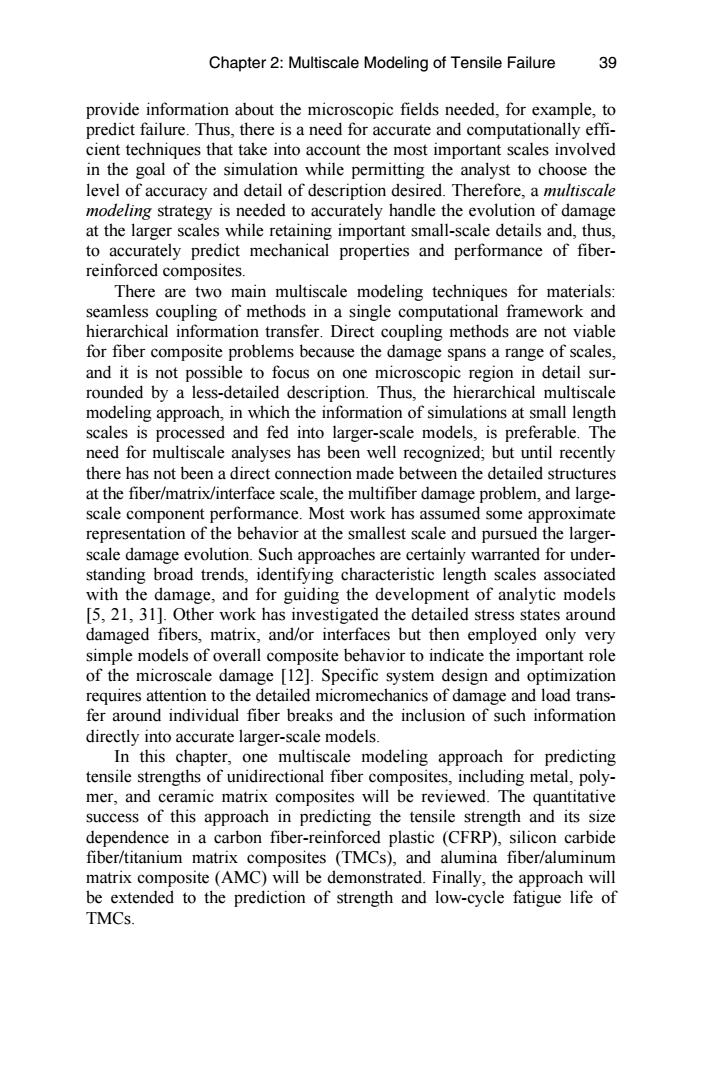正在加载图片...

Chapter 2:Multiscale Modeling of Tensile Failure 39 provide information about the microscopic fields needed,for example,to predict failure.Thus,there is a need for accurate and computationally effi- cient techniques that take into account the most important scales involved in the goal of the simulation while permitting the analyst to choose the level of accuracy and detail of description desired.Therefore,a multiscale modeling strategy is needed to accurately handle the evolution of damage at the larger scales while retaining important small-scale details and,thus, to accurately predict mechanical properties and performance of fiber- reinforced composites. There are two main multiscale modeling techniques for materials: seamless coupling of methods in a single computational framework and hierarchical information transfer.Direct coupling methods are not viable for fiber composite problems because the damage spans a range of scales, and it is not possible to focus on one microscopic region in detail sur- rounded by a less-detailed description.Thus,the hierarchical multiscale modeling approach,in which the information of simulations at small length scales is processed and fed into larger-scale models,is preferable.The need for multiscale analyses has been well recognized;but until recently there has not been a direct connection made between the detailed structures at the fiber/matrix/interface scale,the multifiber damage problem,and large- scale component performance.Most work has assumed some approximate representation of the behavior at the smallest scale and pursued the larger- scale damage evolution.Such approaches are certainly warranted for under- standing broad trends,identifying characteristic length scales associated with the damage,and for guiding the development of analytic models [5,21,311.Other work has investigated the detailed stress states around damaged fibers,matrix,and/or interfaces but then employed only very simple models of overall composite behavior to indicate the important role of the microscale damage [12].Specific system design and optimization requires attention to the detailed micromechanics of damage and load trans- fer around individual fiber breaks and the inclusion of such information directly into accurate larger-scale models. In this chapter,one multiscale modeling approach for predicting tensile strengths of unidirectional fiber composites,including metal,poly- mer,and ceramic matrix composites will be reviewed.The quantitative success of this approach in predicting the tensile strength and its size dependence in a carbon fiber-reinforced plastic (CFRP),silicon carbide fiber/titanium matrix composites (TMCs),and alumina fiber/aluminum matrix composite(AMC)will be demonstrated.Finally,the approach will be extended to the prediction of strength and low-cycle fatigue life of TMCs.provide information about the microscopic fields needed, for example, to predict failure. Thus, there is a need for accurate and computationally efficient techniques that take into account the most important scales involved in the goal of the simulation while permitting the analyst to choose the level of accuracy and detail of description desired. Therefore, a multiscale modeling strategy is needed to accurately handle the evolution of damage at the larger scales while retaining important small-scale details and, thus, to accurately predict mechanical properties and performance of fiberreinforced composites. There are two main multiscale modeling techniques for materials: seamless coupling of methods in a single computational framework and hierarchical information transfer. Direct coupling methods are not viable for fiber composite problems because the damage spans a range of scales, and it is not possible to focus on one microscopic region in detail surrounded by a less-detailed description. Thus, the hierarchical multiscale modeling approach, in which the information of simulations at small length scales is processed and fed into larger-scale models, is preferable. The need for multiscale analyses has been well recognized; but until recently there has not been a direct connection made between the detailed structures at the fiber/matrix/interface scale, the multifiber damage problem, and largescale component performance. Most work has assumed some approximate representation of the behavior at the smallest scale and pursued the largerscale damage evolution. Such approaches are certainly warranted for understanding broad trends, identifying characteristic length scales associated with the damage, and for guiding the development of analytic models [5, 21, 31]. Other work has investigated the detailed stress states around damaged fibers, matrix, and/or interfaces but then employed only very simple models of overall composite behavior to indicate the important role of the microscale damage [12]. Specific system design and optimization requires attention to the detailed micromechanics of damage and load transfer around individual fiber breaks and the inclusion of such information directly into accurate larger-scale models. In this chapter, one multiscale modeling approach for predicting tensile strengths of unidirectional fiber composites, including metal, polymer, and ceramic matrix composites will be reviewed. The quantitative success of this approach in predicting the tensile strength and its size dependence in a carbon fiber-reinforced plastic (CFRP), silicon carbide fiber/titanium matrix composites (TMCs), and alumina fiber/aluminum matrix composite (AMC) will be demonstrated. Finally, the approach will be extended to the prediction of strength and low-cycle fatigue life of TMCs. Chapter 2: Multiscale Modeling of Tensile Failure 39